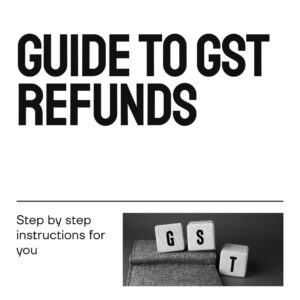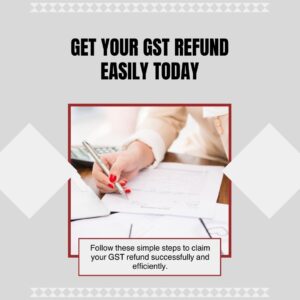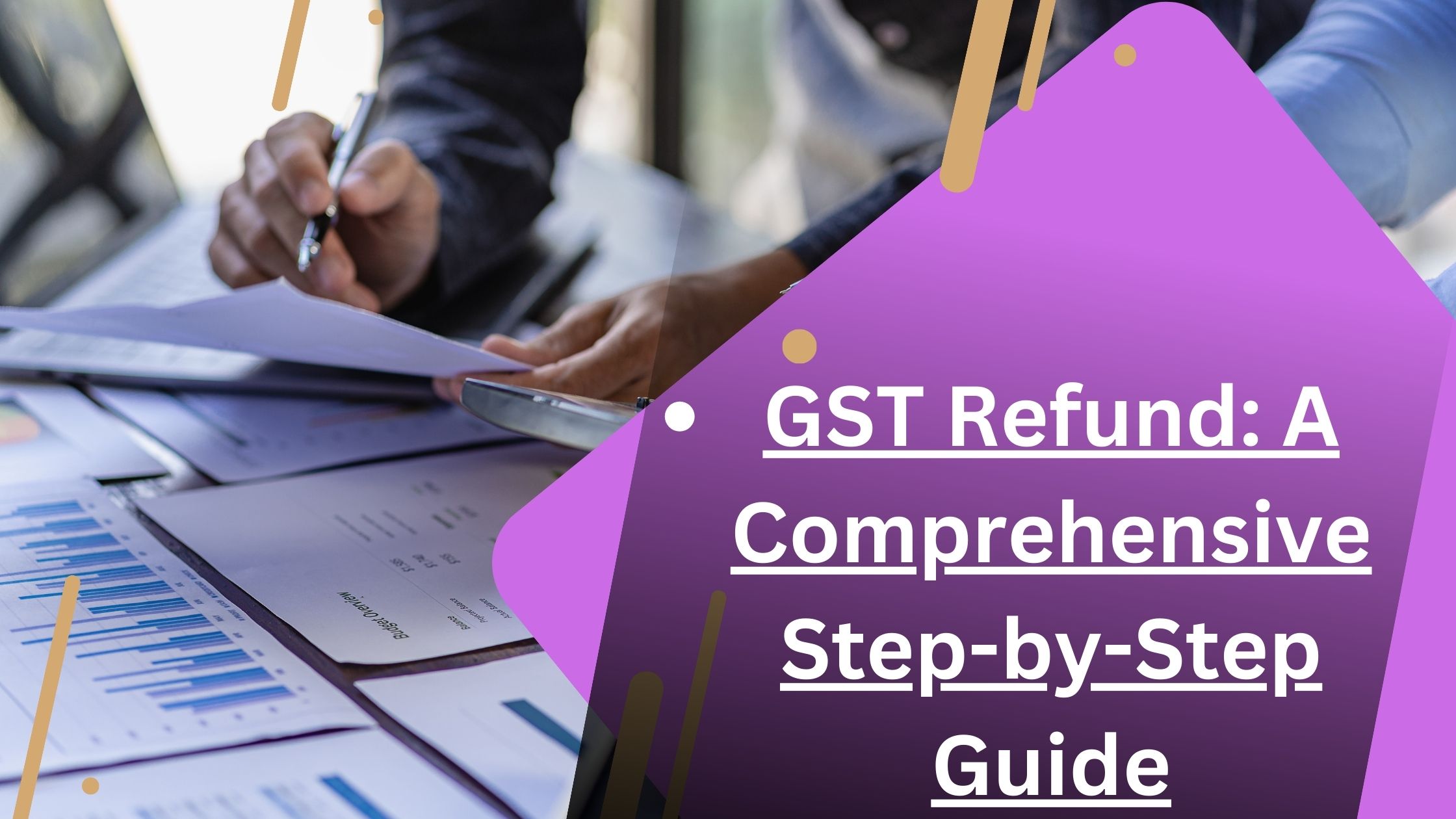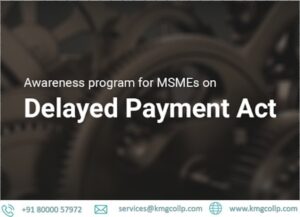The process of claiming a GST refund involves following a defined procedure, submitting necessary documents, and providing declarations where required. Taxpayers must apply to the GST authorities to request a refund for excess payments. Refund claims under GST may arise due to an unutilized balance in the electronic cash ledger, taxes paid mistakenly, or accumulated Input Tax Credit (ITC) that could not be used due to zero-rated sales or an inverted tax structure. We provide the best GST services.
The form required for a GST refund varies depending on the nature of the claim. For example, if claiming a refund for Integrated GST (IGST) on exports made with tax payment, it must be done by reporting the details in GSTR-1 and GSTR-3B. On the other hand, refunds for excess payments in the electronic cash ledger can be requested using Form RFD-01. Hence, the procedure for claiming a refund differs based on the specific type of GST refund being sought.

This guide outlines the step-by-step process for applying for different types of GST refunds.
Latest Updates on GST Refunds
10th November 2022
- Circular 181 was issued to clarify that amendments related to GST refunds will be applicable only from the date of implementation (prospectively).
5th July 2022
- Taxpayers can exclude the COVID-19 pandemic period (from 1st March 2020 to 28th February 2022) when calculating the time limit for filing GST refund applications under Sections 54 and 55 of the CGST Act.
1st February 2022 – Budget 2022 Updates
- Amendment to Section 54: Refund claims for any balance in the electronic cash ledger must be filed in a specific manner as prescribed.
- Change in time limit for UN agencies: The deadline for UN agencies to claim a refund has been extended from six months to two years from the last day of the quarter in which the supply was received.
- Tax default restrictions extended: Earlier, taxpayers with tax defaults were restricted from claiming refunds for unutilized ITC. Now, this restriction applies to other types of refunds as well.
- Refund claims for SEZ supplies: A new sub-clause (ba) has been added to clause (2) of the explanation to clarify the relevant date for filing refund applications related to supplies made to Special Economic Zones (SEZ).
1st May 2021
- If the deadline for passing an order rejecting a refund claim (fully or partially) falls between 15th April 2021 and 30th May 2021, the deadline is extended.
- The revised time limit will be the later of the following two dates:
- 15 days after the reply to the notice OR
- 31st May 2021

Steps to Submit a GST Refund Pre-Application Form
The refund pre-application form is a mandatory submission for taxpayers seeking a GST refund. This form captures essential details such as business information, Aadhaar number, income tax records, export transactions, expenditures, and investments. Filing this form is required for all types of GST refunds.
Since the form does not require a signature and cannot be modified after submission, taxpayers must ensure that all entered details are accurate before proceeding.
The GST refund pre-application process consists of the following steps:
Step 1:
- Log in to the GST portal.
- Navigate to the ‘Services’ tab.
- Click on ‘Refunds’ and select ‘Refund Pre-Application Form’ from the available options.
Step 2: Filling and Submitting the Refund Pre-Application Form
Once the ‘Refund Pre-Application Form’ page appears, taxpayers must enter the required details and click ‘Submit’ to complete the process. Upon submission, a confirmation message will be displayed on the screen.
Key Details to be Provided in the Form:
- Nature of Business – Select from options such as Manufacturer, Merchant Exporter, Trader, or Service Provider.
- Import Export Certificate (IEC) Date (Applicable for Exporters) – If applying for a refund due to exports without tax payment, the IEC issue date must be provided.
- Aadhaar Number – The Aadhaar number of the primary authorized signatory is mandatory.
- Export Value for FY 2019-2020 (For Exporters Only) – The total export value must be calculated at the GSTIN level, not at the PAN level.
- Income Tax Paid for FY 2018-2019 – The amount of income tax paid during the mentioned financial year must be reported.
- Advance Tax Paid for FY 2019-2020 – The details of any advance tax payments made during this period should be included.
- Capital Expenditure & Investments (FY 2018-2019) – The form requires details of any capital expenditures or investments made during the specified financial year.
Refund Process for IGST Paid on Exported Goods (With Tax Payment)
Under GST regulations, exports qualify as ‘Zero-Rated Supplies’, allowing exporters to claim refunds on tax paid, including IGST and any applicable cess. Since exporters often handle large transaction volumes, the GST portal provides a streamlined refund process, eliminating the need for a separate RFD-01 form. However, certain conditions must be met to qualify for the refund.
Key Conditions for IGST Refund on Exports
- Accurate Reporting in GST Returns
- Table 6A in GSTR-1 must be completed with shipping bill details for all export transactions (with tax payment) and filed within the due date.
- A summary of these transactions should also be reported under item 3.1(b) of GSTR-3B, ensuring the corresponding tax is fully paid and returns are filed on time as per GST law.
- Correct Details in Export Invoice Data
- The shipping bill number, shipping bill date, and port code must be accurately mentioned in Table 6A of Form GSTR-1.
- All export transactions for a particular tax period must be reported in both GSTR-1 and GSTR-3B for that same period.
- The total IGST and cess declared in Table 3.1 of GSTR-3B must be equal to or greater than the amounts mentioned in Tables 6A and 6B of GSTR-1.
Processing of IGST Refund by GST & Customs Authorities
- Shipping bill as refund application: The GST system treats the shipping bill as a refund application. Export details from GSTR-1 are sent to ICEGATE (Indian Customs Electronic Data Interchange Gateway), along with confirmation that GSTR-3B has been filed for the relevant period.
- Customs verification: The Customs system matches export data from GSTR-1 with the shipping bill and Export General Manifest (EGM) before processing the refund.
- Refund disbursement: Once the refund is credited to the taxpayer’s account, the ICEGATE system updates the GST portal, which then notifies the taxpayer via SMS and email.
Steps to Apply for GST Refund Using Form RFD-01
Form RFD-01 must be submitted for claiming refunds under various circumstances, including:
Types of GST Refunds That Require RFD-01 Filing
- Refund of Excess Cash Balance – When an excess balance is available in the electronic cash ledger or excess tax has been paid.
- IGST Refund on Export of Services (With Tax Payment).
- Refund of Accumulated ITC – Due to export of goods and services without tax payment.
- Refund of ITC for SEZ Supplies – When supplies are made to an SEZ unit or SEZ developer without tax payment.
- Refund Due to Inverted Tax Structure – When tax paid on inputs is higher than the tax on outputs.
- Refund for Deemed Exports.
- Refund of Tax Paid on SEZ Supplies (With Tax Payment).
- Refund for Incorrect Tax Classification – If a supply was initially classified as intrastate but later determined to be interstate, and vice versa.
- Refund for Deemed Exports Tax Paid by Supplier – If the supplier paid tax on deemed exports but did not collect it from the buyer, they can claim a refund, provided the buyer does not claim it.
- Refund Due to Assessment, Provisional Assessment, Appeal, or Any Other Order.
- Refund for Any Other Reason Using RFD-01.
- Refund Claim by an Unregistered Taxpayer.
Key Requirements Before Filing RFD-01
- Ensure invoice details are correctly reported in both GSTR-1 and RFD-01.
- A certificate from a Chartered Accountant/Cost Accountant is required in specific cases.
Steps to File a Refund Application in Form RFD-01
Step 1: Log in to the GST portal, navigate to the ‘Services’ tab, select ‘Refunds’, and click on ‘Application for Refund’.
Step 2: On the displayed page, choose the reason for the refund or the type of refund, then click on ‘Create refund application’.
Step 3:
- Select the tax period for which the refund is being applied.
- A prompt will ask, “Do you want to file a nil refund?” Choose ‘Yes’ or ‘No’ accordingly.
📌 For Nil Refund Applications
- If selecting ‘Yes’, check the declaration box and proceed to file using Digital Signature Certificate (DSC) or Electronic Verification Code (EVC).
- This step is not applicable for refund types like:
- Excess cash balance in the ledger
- Intrastate supply later reclassified as interstate supply and vice versa
- Refund due to assessment, provisional assessment, appeal, or other orders
Step 4: Enter the required details on the displayed form, which varies based on the type of refund selected in the previous step.
Type 1: Excess Cash Balance in Electronic Cash Ledger
- Enter the amount of cash you wish to claim as a refund.
Type 2: Excess Tax Paid Through GSTR-3B
- Provide details of the GSTR-3B return in which the excess tax payment was made in cash.
Type 3: Accumulated ITC Due to Exports of Goods and Services (Without Payment of Tax)
Step A:
- Download Statement 3 and enter details of export invoices for which the refund is being claimed.
Step B:
- Generate the JSON file and upload it to the GST portal. Ensure that there are no validation errors.
Step C:
- In the “Computation of Refund to be Claimed” section (Statement-3A as per Rule 89(4)), enter:
- Aggregate Turnover
- Adjusted Total Turnover
- Net Input Tax Credit (ITC)
Type 4: Accumulated ITC on Supplies to SEZ Units/SEZ Developers (Without Tax Payment)
Before applying, it is necessary to have filed GSTR-1 and GSTR-3B for the relevant period. The process follows the same steps as outlined for the Type 3 refund. However, in this case, the applicable statement is Statement 5, and instead of a JSON file, a CSV file can be uploaded.
Type 5: ITC Accumulated Due to an Inverted Tax Structure
An inverted tax structure occurs when the tax rate and the amount paid on input supplies exceed those on output supplies. The procedure remains identical to the steps specified for the Type 3 refund. However, applicants must use Statement 1A and enter key details, including turnover from inverted-rated supplies, the tax payable, adjusted total turnover, and net input tax credit.
Type 6: Refund for Recipients of Deemed Exports
A recipient who has paid tax on inward supplies classified as deemed exports and subsequently claimed ITC for the tax paid in their electronic credit ledger is eligible for a refund. However, in such cases, the supplier of the deemed exports cannot claim a refund.
The refund process remains the same as described for the Type 3 refund. However, the required statement in this scenario is Statement 5B. Additionally, applicants must input details such as the net input tax credit related to deemed exports and the corresponding refund amount to be claimed.
Type 7: Tax Paid on Supplies to SEZ Units/SEZ Developers (With Tax Payment)
The procedure is consistent with the steps specified for the Type 3 refund. However, applicants must use Statement 4 in this case. The refund amount will be automatically populated based on the details provided in the uploaded statement.
Type 8: Tax Paid on an Intrastate Supply Later Reclassified as an Interstate Supply (and Vice Versa)
The refund application process follows the same steps outlined for the Type 3 refund. However, in this case, applicants must submit Statement 6. The refund amount will be automatically populated based on the uploaded statement.
Type 9: Refund by the Supplier of Deemed Exports
The procedure remains identical to that of the Type 3 refund. However, applicants must use Statement 5B for submission. The refund amount will be auto-filled based on the details provided in the uploaded statement.
Type 10: Refund of IGST Paid on Export of Services (With Tax Payment)
The steps to apply for this refund are the same as those detailed for the Type 3 refund. However, applicants must submit Statement 2. The refund amount will be auto-calculated and populated based on the uploaded statement.
Type 11: Refund Due to Assessment, Provisional Assessment, Appeal, or Other Orders
Applicants must select the relevant type of order and enter its details as per the provided format.
Type 12: Refund Under ‘Any Other Ground’
Refunds under this category may arise due to reasons such as excess interest paid through GSTR-3B. Clearly specify the reason for the refund within a 200-character limit and enter the corresponding amount.
Step 5: Provide Bank Account Details, Upload Documents, and Submit Declaration
For refund categories that require it, enter the bank account details, upload supporting documents, and submit the necessary declarations.
Applicants can upload up to 10 supporting documents, with each file not exceeding 5 MB in size.
Review the completed application and click ‘Save.’ The saved application will be available for up to 15 days for further action. Once ready, check the boxes for the undertaking and self-declaration, then click ‘Proceed’ to finalize the submission.
Step 6: Submit RFD-01 Using EVC or DSC
Finalize the refund application by filing Form RFD-01 using either an Electronic Verification Code (EVC) or Digital Signature Certificate (DSC).
Once submitted, an Application Reference Number (ARN) is generated and displayed on the screen. Taxpayers can use this ARN to track the status of their refund request. Additionally, the ARN is sent via email and SMS to the registered contact details.
After submission, the application is assigned to a refund processing officer, who will review and process the request. The status of the refund will be updated accordingly.
Refund Claim by an Unregistered Person
An unregistered individual must first obtain GST registration before applying for a refund. The refund application should be submitted through Form RFD-01, accompanied by Statement 8, a supplier certificate, and relevant supporting documents.
GST Refund Process for Embassies and International Organizations
Refunds for embassies and international organizations can be claimed in two ways:
- Using GSTR-11: Generate a refund application through Form RFD-10.
- Accessing RFD-10 on the GST Portal: Retrieve the RFD-10 form from the dashboard after logging in.
For the first method, navigate to the already filed GSTR-11 by selecting the relevant tax period or quarter, then click on the ‘Generate RFD-10’ button.
Preview and submit using DSC or EVC.
For the second method, after logging into the GST portal, navigate to the dashboard and follow these steps:
- Go to the ‘Services’ tab and select ‘Refunds’.
- Choose the ‘Application for Refund’ option.
- On the displayed page, select ‘Embassy/International Organisation’ as the refund category and click ‘Create’.
The system will automatically populate the eligible tax refund details from the previously filed GSTR-11.
What Happens After Applying for a GST Refund?
Once a taxpayer submits a GST refund application, it appears on the dashboard of the tax officer or refund processing officer as a pending task. The officer then reviews and verifies the application along with the supporting documents.
Tracking the Refund Application
Taxpayers can track the refund status using the “Track Application Status” option under the Refunds section. After approval from the GST authorities, the refund amount is credited to the applicant’s bank account.
Actions Taken by the Tax Officer
- Provisional Refund (RFD-04)
- Issued for specific refund categories.
- Must be granted within 7 days from the acknowledgment date.
- At least 90% of the claimed refund is released provisionally.
- Acknowledgment (RFD-02)
- Issued within 15 days if the application is complete.
- Withdrawal of Refund Application (RFD-01W)
- The applicant can withdraw the refund request.
- If withdrawn, the debited amount from the electronic cash/credit ledger is re-credited.
- Deficiency Memo (RFD-03)
- Issued if the officer finds errors in the application.
- The refund amount is auto re-credited to the taxpayer’s electronic ledger.
- The applicant must file a fresh application.
- Clarification Notice (RFD-08 & RFD-09)
- If the refund application has issues or was granted mistakenly, the officer issues RFD-08.
- The taxpayer must respond within 15 days using RFD-09.
- Sanction or Rejection Order (RFD-06 & RFD-05)
- If the refund is approved, a sanction order (RFD-06) is issued.
- A payment order (RFD-05) follows the sanction for disbursing the refund.
- Withholding Refund (RFD-07 Part-B)
- The officer may withhold the refund for specific reasons.
- In such cases, RFD-05 is not issued.
- Re-credit Order (PMT-03)
- If a refund is denied or withdrawn, the officer re-credits the amount to the taxpayer’s electronic ledger.
- This applies even when a provisional refund was granted earlier.
Need Help?
FAQs
1. What is a GST refund?
A GST refund is the process through which a taxpayer can claim back excess tax paid, input tax credit (ITC) accumulated, or tax paid on exports and other eligible transactions.
2. Who can apply for a GST refund?
Any registered taxpayer, including businesses, exporters, SEZ units, embassies, international organizations, and in certain cases, unregistered persons, can apply for a GST refund.
3. What are the common reasons for claiming a GST refund?
GST refunds can be claimed for various reasons, including:
- Excess tax paid through GSTR-3B
- Accumulated ITC due to exports (without tax payment)
- IGST paid on exports (with tax payment)
- ITC accumulated due to an inverted tax structure
- Tax paid on deemed exports
- Tax paid on supplies to SEZ units/developers
- Tax paid on transactions later classified as inter/intrastate supply
- Refunds due to assessment, appeal, or other orders
4. How can I apply for a GST refund?
You can apply for a GST refund by logging into the GST portal, navigating to the ‘Refunds’ section, and selecting the appropriate refund type. You must then fill out Form RFD-01, upload the necessary documents, and submit the application.
5. Do I need to file a separate refund application for IGST paid on exports?
No, a separate application is not required. The shipping bill itself acts as a refund application, provided that export details are correctly filed in Table 6A of GSTR-1 and Table 3.1(b) of GSTR-3B.
6. What documents are required for a GST refund claim?
The required documents depend on the type of refund but may include:
- Export invoices and shipping bills
- Bank account details
- GSTR-1 and GSTR-3B filings
- Statement of invoices (CSV or JSON files)
- Chartered accountant/cost accountant certificate (in certain cases)
7. How long does it take to process a GST refund?
- Provisional refunds (90%) for certain types are issued within 7 days (Form RFD-04).
- Acknowledgment (RFD-02) is issued within 15 days of application submission.
The complete refund process may take 30–60 days, depending on scrutiny by tax authorities.
8. How can I track my GST refund application?
You can track your refund status using the “Track Application Status” feature in the Refunds section of the GST portal.
9. What happens if my refund application is found deficient?
If any deficiencies are found, the tax officer issues a Deficiency Memo (RFD-03), and the refund is auto re-credited to the electronic ledger. A fresh refund application must be filed.
10. Can a taxpayer withdraw a refund application?
Yes, taxpayers can withdraw a refund application using Form RFD-01W. Upon withdrawal, the debited amount is re-credited to the taxpayer’s electronic credit or cash ledger.
11. What happens if a refund is wrongly granted?
If a refund is granted by mistake or requires further clarification, the tax officer issues a Show Cause Notice (RFD-08). The taxpayer must respond within 15 days using Form RFD-09.
12. What is the role of Form RFD-06 and RFD-05?
RFD-06 is the final sanction or rejection order for the refund.
RFD-05 is the payment order issued after approval.
13. What if the refund is withheld?
If the tax officer decides to withhold the refund, an order is issued using Form RFD-07 (Part-B), and no payment order (RFD-05) is generated.
14. Can embassies and international organizations apply for a GST refund?
Yes, embassies and international organizations can claim GST refunds by filing Form RFD-10, which can be generated from GSTR-11 or directly accessed on the GST portal.
15. What happens if my refund is rejected?
If a refund is rejected, the amount is re-credited to the electronic ledger using Form PMT-03, and the taxpayer may need to file a fresh application if eligible.
16. Can an unregistered person claim a GST refund?
Yes, an unregistered person can apply for a refund in Form RFD-01 using Statement 8, along with a supplier certificate and supporting documents.
Table of Contents
Toggle


